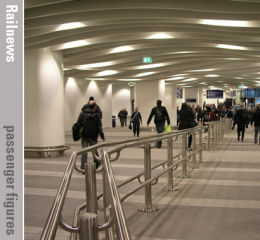Posted 13th June 2019 | No Comments
Passenger figures are rising again

THE number of railway journeys made between April 2018 and March this year set a new record, according to the Office of Rail and Road.
The ORR says the total for 2018-19 was 1.759 billion journeys. The figure was driven by a 3 per cent increase nationally, amounting to about 50 more million journeys.
Travel in the London & South East sector rose more sharply, by 3.9 per cent, reversing falls which had been recorded in the two previous years.
Season ticket purchases are still easing back, however, although the latest fall of 0.4 per is less than it was in the two previous years. Season ticket holders account for just 36 per cent of journeys now compared with 48 per cent a decade ago.
By contrast, journeys made with Anytime tickets were up by 6.9 per cent.
Revenue reached £10.3 billion in 2018-19, rising by 6.1 per cent – the highest annual rise since 2014-15 – while passenger kilometres were also up, at 67.7 billion. Again, the highest increase was recorded in London and the south east. The L&SE sector also leads the way by earning almost half of the national passenger revenue.
Rail Delivery Group chief executive Paul Plummer said: ‘Rail companies are changing and improving today, running thousands of extra services every week so that more people can benefit from taking the train and our communities are better connected. The long-term decline in season tickets, despite the continued growth in commuting, shows that the rail fares system needs to change to match how people live and work today. This is why we want to work with government on proposals to update regulation that would support flexible working.’
Analysis
Sim Harris
AS ever, these new statistics have to be considered carefully, particularly because ‘journey’ in the ORR world means a trip on one train. A passenger who needs three trains to get from A to D, changing at B and C on the way, is counted as having made three journeys, and a return ticket would count as six journeys, rather than two.
The total effect of this is to inflate the final figures by about 19 per cent. If you want to know how many passengers used the railway, irrespective of the number of trains used to complete their trips, the total comes down to 1.475 billion. This is admitted by the ORR in a separate table of statistics, called Regional Rail Journeys.
1.475 billion is still historically high, being more than the total for 1945, which used to be regarded as a record, and rivalling the totals in the early 1920s. It is sometimes pointed out that the network was twice the size in those days, but many of the lines which have disappeared since then could not have been very busy ones.
What are more useful are the trends which the ORR’s figures for 2018-19 have revealed. After a couple of years of retreat, the number of people travelling by train is rising again, which suggests that the pause over the previous two years could have been due to special circumstances, such as the prolonged industrial action on Southern. An re-established increase in demand should make it easier to justify railway investment over the next few years.
